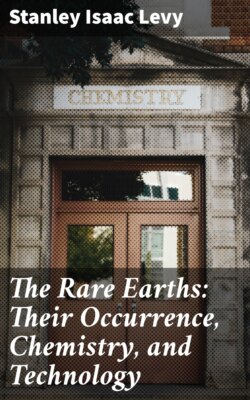Читать книгу The Rare Earths: Their Occurrence, Chemistry, and Technology - Stanley Isaac Levy - Страница 160
На сайте Литреса книга снята с продажи.
Allanite.
Оглавление—Allanite, or Orthite, as it is often called, is a mineral of the epidote family, containing rare earths. The general formula for Epidote is H₂O,4R´´O,3R´´´´₂O₃,6SiO₂, where R´´ is a divalent and R´´´ a trivalent metal, or vicarious series of metals. In the case of Allanite, R´´ = (Fe´´,Ca), R´´´ = (Al,Fe´´´,E), where E stands for metals of the cerium and yttrium groups (Engström’s formula). Groth formulates it as a basic salt, R´´´₃(OH)R´´₂Si₃O₁₂, of the acid H₁₂Si₃O₁₂ (= 3H₄SiO₄).
Crystals are fairly common, but the mineral usually occurs massive or in rounded grains.
Crystals—Monoclinic, holosymmetric; a: b: c = 1·5509: 1: 1·7691, β = 64° 59´.
Common forms—Ortho- and basal pinakoids a {100} and c {001}; m {110} and other prisms, e {101} and other hemi-ortho-prisms, o {011}, d {111} and other hemi-pyramids.
Angles, (100) ∧ (110) = 54° 34´; (001) ∧ (101) = 63° 24´; (001) ∧ (011) = 58° 3´.
Tabular, parallel to a, or long and slender by elongation parallel to axis b.
Birefringence weak, variable. Refraction strong. Colour brown to brownish-black; almost opaque. In flakes very strongly pleochroic, the colours for light parallel to the three vibration directions c, b and a being brownish-yellow, reddish-brown, and greenish-brown respectively.
Brittle. Hardness 51⁄2-6; sp. gr. 3·5-4·2.
On heating, allanite becomes amorphous and isotropic with increase of specific gravity (cf. Gadolinite). Before the blowpipe it loses water, and melts to a black magnetic glass, many varieties phosphorescing strongly (vide supra). With hydrochloric acid it gelatinises, unless previously heated strongly, in which case it is not attacked.
Analyses show that the rare earth content varies considerably (vicariously as regards ferric iron and aluminium), ceria earths varying from 3·6 to 51·1 per cent. and yttria earths from traces up to 4·7 per cent.[37] Thoria is usually present, 0 to 3·5 per cent. In 1909 Fromme[38] found small quantities of beryllia in the mineral, and in 1911 Meyer[39] found amounts of scandium oxide up to 1 per cent. It contains traces of uranium, and is weakly radioactive. Ramsay, Collie and Travers found no helium (1895), but in 1905 Strutt found radium in it, so that the presence of helium seems a priori probable.
[37] Vide Schilling, pp. 70-75 for analyses of this mineral.
[38] Fromme, Tsch. Min. Mitt. 1909, 28.
[39] Meyer, Sitzungsber. königl. Akad. Wiss. Berlin, 1911, 379.
Many varieties of the mineral are known, differing in habit, colour, water content, specific gravity, etc., and the percentage composition varies very much by reason of vicarious replacement of the bases. Goldschmidt[40] has found ‘Epidote-orthites’ which are isomorphous mixtures of orthite with an iron epidote; he concludes that most orthites are probably similar solid solutions, and in this way accounts to a large extent for the varying composition.
[40] Centr. Min. 1911, 4.
Allanite is of very wide distribution, though it is not often found in large quantities. The usual occurrence in pegmatitic veins in granites, syenites and other acid plutonic rocks has been often noted, e.g. in many parts of Sweden and Norway. It is found also in the extinct crater now forming the Laacher See, near Coblenz, Germany, and at Impilaks, near Lake Ladoga, on the border of Finland; a mass of the pure mineral weighing 300 lb. was recently discovered at Barringer Hill, (cf. under Gadolinite), and it occurs in large quantities in Amherst Co., Virginia. It is an accessory constituent of many acid volcanic and hypabyssal rocks, and has been found also in limestone, and in magnetic iron ores. On account of its exceedingly wide distribution, and the variations in appearance and composition, it has been repeatedly described under various names, varieties being constantly mistaken for new mineral species.
Its history is rather curious.[41] In 1806 the Danish mineralogist Giesecke made a protracted voyage to Greenland, collecting minerals and rocks; he remained there until 1813. In 1808 he sent off his first collection by ship to Copenhagen; on the voyage the ship was taken by an English privateer, and the cargo landed and sold at Leith. The minerals were bought by Allan, a Scotch mineralogist, who recognised, that they were from Greenland by the presence of cryolite, at that time only known to occur in Greenland. He mistook the mineral subsequently named after him for gadolinite, and sent it to Thomson for analysis.[42] Thomson recognised it as a new mineral, and named it Allanite (1810). In 1815 Hisinger described a mineral from Ryddarhyttan, Sweden, which he called Cerin; Leonhard (1821) and Hauy (1822) showed that this was identical with Allanite. In 1818 Berzelius described two varieties of a mineral from Finbo, near Fahlun, Sweden, which he called Orthite, and Pyrorthite; these were eventually shown by Scheerer (1844) to be varieties of Allanite. In 1824 the French mineralogist Lévy described a mineral from Arendal, Norway, which he named Bucklandite, in honour of the English naturalist; in 1825 this was identified with a ‘black zeolite’ from the Laacher See by G. Rose, and in 1828 both were shown by Hermann to have the same composition as orthite or allanite. The list might be extended at will; the Tautolite of Kokscharow (1847), the Bodenite of Breithaupt (1844), the Muromontite of Kemdt (1848), and the Vasite of Bahr (1863) have all been shown to be varieties of the same bewildering mineral.
[41] Vide Schilling, pp. 75-76, where full references are given.
[42] See Kobell’s Geschichte der Mineralogie, 1864, p. 679.
